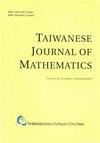方向可微性,协微分,协微分和多面体DC函数
IF 0.6
4区 数学
Q3 MATHEMATICS
引用次数: 0
摘要
共微分和coexhausters用于描述非光滑函数的非齐次逼近。尽管coexhausters是共微分的现代推广,但这两个概念的理论仍在同时发展。此外,共微分和共xhausters与DC函数有很强的联系。在本文中,我们追踪了所有这些对象之间的类比,并证明了用这些概念描述的有界性和最优性条件的等价性。这允许将根据一个对象得出的结果扩展到通过另一个对象提出的问题。本文的另一个贡献是研究了非齐次近似与方向导数之间的联系,并用非齐次逼近的形式给出了最优性条件。引言在非光滑分析[1]的各种方法中,拟微分方法因其构造性而脱颖而出。这种方法的一个重要优点是,所有的工具和方法不仅可以在理论上建立和使用,而且可以在实际问题中使用。这种方法可以追溯到80年代初,当时Demyanov、Rubinov和Polyakova提出并研究了拟微分的概念[2-5]。拟微分是一对凸紧集,使人们能够以线性函数的最大值和最小值的和的形式表示函数在一点上的方向导数。拟微分享有完整的微积分,它允许计算各种函数的拟微分。这样的函数也称为拟可微函数。Polyakova和Demyanov根据这些对象导出了最优性条件,并展示了当这些条件不满足时如何找到最陡下降和上升的方向。这为建造新的本文章由计算机程序翻译,如有差异,请以英文原文为准。
Directional Differentiability, Coexhausters, Codifferentials and Polyhedral DC Functions
Codifferentials and coexhausters are used to describe nonhomogeneous approximations of a nonsmooth function. Despite the fact that coexhausters are modern generalizations of codifferentials, the theories of these two concepts continue to develop simultaneously. Moreover, codifferentials and coexhausters are strongly connected with DC functions. In this paper we trace analogies between all these objects, and prove the equivalence of the boundedness and optimality conditions described in terms of these notions. This allows one to extend the results derived in terms of one object to the problems stated via the other one. Another contribution of this paper is the study of connection between nonhomogeneous approximations and directional derivatives and formulate optimality conditions in terms of nonhomogeneous approximations. Introduction Among the variety of approaches of nonsmooth analysis [1] the method of quasidifferential stands out due to its constructiveness. One important advantage of this approach is that all the tools and methods can be built and used not only theoretically but also in practical problems. The approach goes back to the early 80-th when Demyanov, Rubinov and Polyakova proposed and studied the notion of quasidifferentials [2–5]. Quasidifferentials are pairs of convex compact sets that enable one to represent the directional derivative of a function at a point in a form of sum of maximum and minimum of a linear functions. Quasidifferentials enjoy full calculus, that grants the calculation of quasidifferentials for a rich variety of functions. Such functions are also called quasidifferentiable. Polyakova and Demyanov derived optimality conditions in terms of these objects and also showed how to find the directions of steepest descent and ascent when these conditions are not satisfied. This paved a way for constructing new
求助全文
通过发布文献求助,成功后即可免费获取论文全文。
去求助
来源期刊
CiteScore
1.10
自引率
0.00%
发文量
35
审稿时长
3 months
期刊介绍:
The Taiwanese Journal of Mathematics, published by the Mathematical Society of the Republic of China (Taiwan), is a continuation of the former Chinese Journal of Mathematics (1973-1996). It aims to publish original research papers and survey articles in all areas of mathematics. It will also occasionally publish proceedings of conferences co-organized by the Society. The purpose is to reflect the progress of the mathematical research in Taiwan and, by providing an international forum, to stimulate its further developments. The journal appears bimonthly each year beginning from 2008.

 求助内容:
求助内容: 应助结果提醒方式:
应助结果提醒方式:


